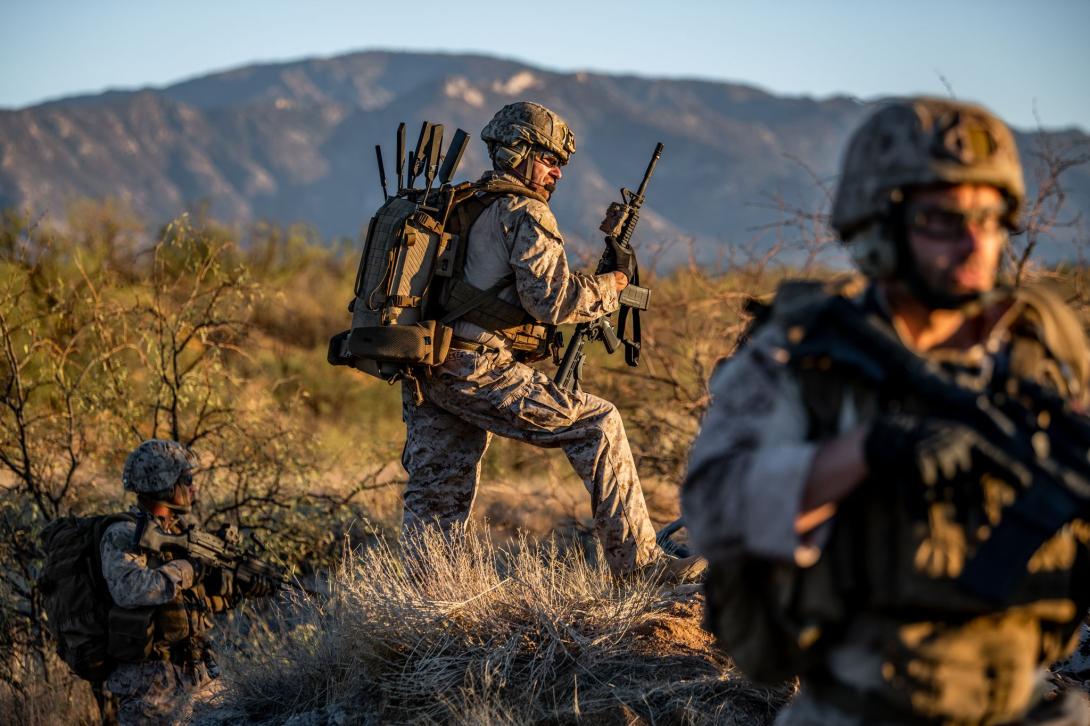Communications: Enabling Next-Generation Command and Control
The future of defense communications relies on agile, secure and scalable networks that empower warfighters to dominate the information domain—even in the most contested and austere environments. As modern conflicts grow increasingly complex, the need
for real-time adaptability, cyber resilience and seamless interoperability becomes mission critical.
The Future of Warfare Depends on Communications
The war between Russia and Ukraine is completely remaking how conflicts will be conducted in the 21st century.
Ukraine has fought off the Russian invasion for more than three years, and Russia has gained little territory after early successes, even though Russia is about 28 times the size of Ukraine and its population is approximately 3.7 times larger. The Russian military is far larger—bigger budget, much more military hardware and many more troops—and includes nuclear weapons.
But the smaller country has demonstrated the flexibility and imagination that changes the equation. Most recently and daringly, on June 1, Ukraine’s intelligence service launched a multifaceted drone attack called Operation Spiderweb that targeted Russian military aircraft, some of them thousands of miles within Russia.
Ukrainian officials have talked publicly about the planning of the attack, the methods used to hide the drones to get them close to their targets and the outcomes. What they have declined to talk about: the communications technologies used to launch and control the drones.
This real-world demonstration of the importance of private, secured network communications is why Nokia Federal Solutions is now a standalone company, spun off from Nokia Corp.
When Nokia Federal was part of its Finnish parent company, Nokia Corp., it faced restrictions on the types of federal contracts it could hold due to foreign ownership. To resolve this and better serve U.S. defense needs, Nokia Federal was spun off under a U.S.-based proxy board. “Finland is a brand-new NATO member and I think the intent here is to be as good a partner as they can be,” said Dave Peterson, vice president of Tactical and Business Development at Nokia Federal Solutions. “For that reason, they gave up control of Nokia Federal to a proxy board so they could be an effective partner.”
Now that Nokia Federal is separate, “this enhances Nokia Federal’s ability to work with the federal government. Having facilities clearances means Nokia’s entire product portfolio is now available,” he said.
The change goes beyond Nokia Federal’s relationship to its former parent. “While we can now bring Nokia products and technology directly to the federal government, we’ll continue to work with partners,” said Steve Vogelsang, chief technology officer of Nokia Federal Solutions. “Where necessary, we’ll enhance Nokia products for the defense sector—we have that flexibility.”
Connecting the Tactical Edge to the Cloud
Troops on the ground face conflicting communications priorities: on the one hand, they need real-time information about the foes they face—the enemy’s disposition, weaponry and objectives. On the other hand, warfighters are tasked with providing commanders behind the lines—sometimes mere miles, sometimes a continent away—that same information about the foes they are facing, as quickly as possible.
Addressing these two responsibilities, one incoming and the other outgoing, is a major part of the Department of Defense’s strategic vision, the concept of Joint All-Domain Command and Control (JADC2).
Nokia Federal already has the communications parts and pieces to help make JADC2 a reality. Its Banshee mobile radio is a cellular edge network device capable of supporting up to 800 endpoints around a large geographic area. That capability addresses the immediate data intelligence and communications requirements in a battlespace. Further, the systems scale and integrate into current military infrastructure.
“Banshee is the tactical edge. It’s the thing that’s going to connect directly to a warfighter on the battlefield,” Vogelsang said. “But what happens when they get connected? What do they want to get connected to? Ultimately, it’s the cloud.”
Connecting to the cloud is important because that is where mission-critical services live. Fires cannot go kinetic without intelligence and positive identification—which come from centers of excellence that push intelligence data down to the troops who pull the triggers.
Thus, the next step is to build out the infrastructure to connect to satellites, to other secure IP networks, and to the host of devices and sensors that gather and transmit data, from unmanned vehicles to robots to unmanned aerial systems conducting intelligence, surveillance and reconnaissance. The goal is to turn collated data intelligence, maybe from a sensor the user can’t even see—into shoot/no-shoot decisions as fast as possible, and at the lowest echelons of command.
And all that raw data must be transmitted to a Department of Defense (DOD) private cloud for collation, analysis and decision making by military leadership.
“If you look at what the U.S. military is doing in the Indo-Pacific [region], the intent is to connect every warfighter to all the available sensors in the theater. The military has a whole lot of them,” Peterson said. “Exquisite sensor systems[like] aircraft that can sniff radiological particles. There are high-end camera systems. But that data can’t go anywhere without a data fabric.”
What Nokia Federal brings to the table for the DOD is the ability to augment its existing data networks with very high bandwidth, secure data pipes to move that data across a theater like the Pacific, creating that data fabric. “And that’s currently the gap for DOD,” Peterson said. “They have some, but they need more as they enable more sensors and the sensors become more precise, more granular. That’s the magic sauce that Nokia has.”
Vogelsang agreed. “The breadth of our portfolio—wireless, 5G, optical IP routing, microwave, data center switching—there’s no other company friendly to DOD and the NATO alliance that has the complete portfolio. This gives us much better knowledge, an understanding of the end-to-end story and how things need to play together. ... We can see the big picture.”
The Strategy, Tactics—and Acquisition—of Communications
The U.S. military already has aggregation of data intelligence at the strategic level through its use of private cloud. Nokia Federal’s contribution to improvements there is by focusing on projects like campus installation of 5G fiber, IP routing and bringing that cloud down to the edge, Peterson said.
“Once you leave that strategic enclave … and move into an operational setting or a theater, that theater command needs to be able to operate independently from the strategic headquarters element,” Peterson explained. “Once you start geographically dispersing your [forces] around the globe, it’s great if you have connectivity with your higher echelon, but if you’re in a fight you might not. One of your enemy’s priorities is to deny you the ability to communicate with your command. We call that mission command at a tactical level—something Nokia Federal is very focused on, as well.
“When you get into the nitty-gritty, last-mile tactical edge, we’re focused on enabling edge cloud in that environment,” Peterson continued. “If I lose connectivity to my operational command and strategic command because the satellites have been knocked out in some horrible future conflict, I still need the ability to collect and disseminate data intelligence to my troops. I still need to communicate with fire systems and sensors digitally. I can’t do that if I’m limited to push-to-talk.”
JADC2 does a very good job of expressing the DOD vision for the future of U.S. military forces, Peterson said, and the service branches also are quite clear on where they want to be in the future, in terms of capabilities. But it is up to technology companies such as Nokia Federal to bring tangible solutions to the table.
“What we’re doing right now [at Nokia Federal] is building systems and tools and products and teams to show the military how to achieve that vision,” Peterson said. “Lt. Gen. Jim Richardson, when he was at Project Convergence—he’s retired now—said something that we use in some of our proposals. He said, ‘the network is the center of gravity for everything that we do.’ So he knew the network is extremely important to enable things like Project Convergence to happen. He didn’t know exactly how to put it together—nor should he. Gen. Richardson wasn’t a [radio access network] engineer or a technologist who develops communications products.”
Vogelsang said the military does a superb job of explaining what warfighters need, but the how must come from industry. And from across the sector, large, medium and small contractors alike.
“They know that they need to leverage industry much more than they have, which is a complicated proposition for them,” Vogelsang said. “The way the government has procured historically has been through traditional defense contractors where they lay out a need, the contractor comes back with a specific proposal for how to address that need. What we’re doing is a little bit different.
“We’re taking technology that’s already been developed and paid for by industry, already being deployed globally, like 5G networks and such. And we’re coming to the DOD and saying, ‘Hey, we understand your need and we know how to adapt this technology to fill it. That’s going to translate into your getting the capability faster than if we had to go build it from scratch. And you’re going to get it at lower cost because we’ve already paid the vast majority of the R&D bill,’” Vogelsang said.
Conclusion
Nokia Federal is advancing the DOD mission with a comprehensive, end-to-end portfolio that spans tactical private wireless and strategic optical transport infrastructure, leveraging its deep technological expertise to adapt to the military’s unique requirements.
Encompassing everything from 5G tactical private wireless solutions that deliver secure, mission-critical communications and enhanced situational awareness at the edge, to quantum-safe networking technologies designed for long-haul optical transport and backbone routing across global and domestic defense networks, Nokia Federal Solutions is redefining both the tactical and strategic edge.
These interoperable technologies integrate seamlessly with existing systems to give defense forces a decisive advantage across every domain of operation.
For more information visit Nokiafederal.com




Comments